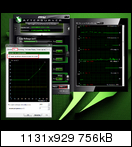Hello taukung,
it would be good if you can test the PoV UC clockrates on your new Asus and the suitable VCore for it (with
NVIDIA Inspector or
MSI Afterburner (each link for the newest version

)), because it isn't easy to calculate what VCore your card will need to work stable - every card has it's own attitude when it comes to overclocking capabilities.
I guess it could be a VCore between 1.000V and 1.050V, but i'm not sure.
I personaly use one of the OC-Tools combined with GPUTool's artefact scan / stability test.
At first I let warm up the card in a few minutes with default clockrates an then I set a new core/shader-clock (and don't touch the memory-clock at this time) and test if the artifacts disappear and no new are in the screen for about 300 seconds (5 minutes). If everything went fine, I adjust a higher core-clockrate (in 25 MHz steps for example). When it comes to artifacts I set 1 Voltage level higher and wait if any more artifact(s) appear for that (new) period and so on.
If I have found the voltage for the goal core/shaderclock I set a higer memory clock and check if the VCore must be increased or not - then I set a higher memory clock again...and so on.
When all goal clocks are reached I think it's good to let run the stability test for a longer time - for example 15 or 30 minutes.
I think that GPUTool is a good and practical tool to test stability.
I guess it doesn't push the hardware to it's limit like OCCT, but if a setting (clockrates and VCore) is stable in GPUTool it should be stable in games, too.
Here you can download GPU Tool, if you want to test it's stability test:
http://www.techpowerup.com/downloads/1383f/GPUTool_CTP1.exe
I allready set the clocks in your bios and waiting for your result of finding a matching VCore for the Ultra Charged clockrates.

If you want to adjust the fanspeed or it's characteristic line in general I would recommend MSI Afterburner
(sorry, at the moment this is the only way) - you can let it startup with a custom-fan-control after booting the OS.


greetings
Edge















